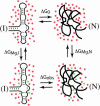A guide to ions and RNA structure
- PMID: 14970378
- PMCID: PMC1370927
- DOI: 10.1261/rna.5205404
A guide to ions and RNA structure
Abstract
RNA folding into stable tertiary structures is remarkably sensitive to the concentrations and types of cations present; an understanding of the physical basis of ion-RNA interactions is therefore a prerequisite for a quantitative accounting of RNA stability. This article summarizes the energetic factors that must be considered when ions interact with two different RNA environments. "Diffuse ions" accumulate near the RNA because of the RNA electrostatic field and remain largely hydrated. A "chelated" ion directly contacts a specific location on the RNA surface and is held in place by electrostatic forces. Energetic costs of ion chelation include displacement of some of the waters of hydration by the RNA surface and repulsion of diffuse ions. Methods are discussed for computing both the free energy of the set of diffuse ions associated with an RNA and the binding free energies of individual chelated ions. Such calculations quantitatively account for the effects of Mg(2+) on RNA stability where experimental data are available. An important conclusion is that diffuse ions are a major factor in the stabilization of RNA tertiary structures.
Figures





References
-
- Amzel, L.M. 1997. Loss of translational entropy in binding, folding, and catalysis. Proteins 28: 144–149. - PubMed
-
- Anderson, C.F. and Record Jr., M.T. 1995. Salt-nucleic acid interactions. Annu. Rev. Phys. Chem. 46: 657–700. - PubMed
-
- Braunlin, W.H. 1995. NMR Studies of cation-binding environments on nucleic acids. Adv. Biophys. Chem. 5: 89–139.
Publication types
MeSH terms
Substances
Grants and funding
LinkOut - more resources
Full Text Sources
Other Literature Sources
